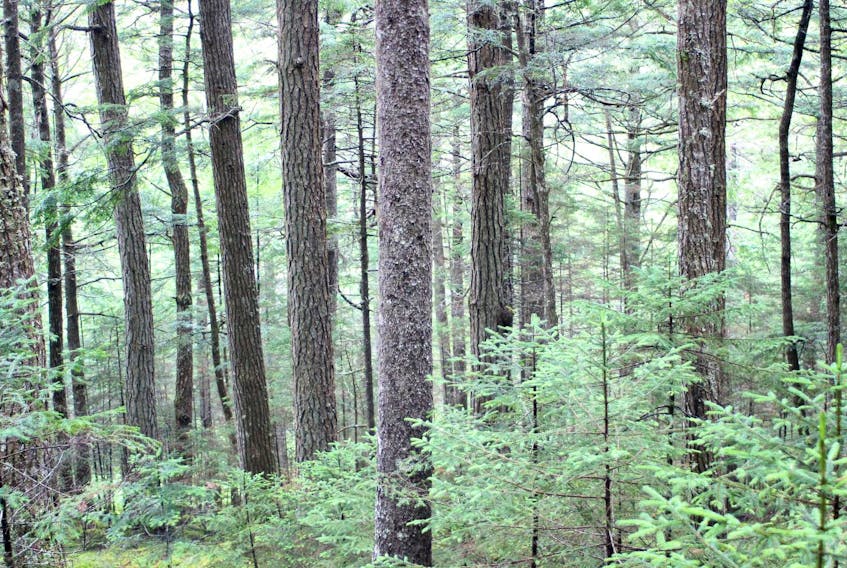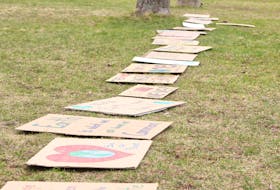Let’s talk about old-growth forests and what they mean for the future of Nova Scotian biodiversity. While such forests used to cover a substantial portion of the province prior to European settlement, today they account for less than 0.01 per cent. Here is an unsustainable legacy, where simple seniority is a hard thing to find.
I’ve had the privilege of walking through many of these forests, from the untouched pockets of glowing hardwood in the Cape Breton Highlands to the colossal eastern hemlocks and red spruce hiding in nooks throughout the mainland, always small and inaccessible, standing firm on a steep slope, riverside cliff or mosquito-infested swamp where chainsaws struggle.
This spells out a crisis for our provincial forests, held as they are in perpetual youth, dominated by early successional species of tree and lacking much in the ecological productivity which produces clean air, water and soil. The absence of old-growth also starves those species of flora and fauna dependent on such maturity, with several endangered birds, mammals and lichen coming readily to mind.
But our surviving old-growth has yet one more indispensable property. Contained within are all the ingredients for a restored Nova Scotia. Should we ever want to regrow our lost natural heritage and crane our necks backward in humble wonder, these forests will help us do so, spreading slowly but surely from the tiny lots on which we’ve confined them. They must endure, lest their bounteous biodiversity disappear forever.
I bring all this up because our old-growth is in no way secure. In fact, recent events suggest just the opposite.
Whether a forest is genuine old-growth is not determined by a careful inventory of its natural features, or the fleeting species taking refuge therein. Instead it’s determined by a score sheet, put out by the Department of Lands and Forestry so that anyone with reasonable qualifications can survey with zeal. Some such qualified people have told me this sheet is fairly accurate, taking into account forest density, signs of past harvests, quantities of deadwood and a few other quickly acquired data. I’ve seen it done, with the cored age of surrounding trees aiding the paper’s determination, but alas, the sheet has its flaws.
A stretch of old-growth cedars protected on Prince Edward Island ended up failing the Nova Scotian score sheet, likely because cedar forests behave differently from those of hemlocks, the staple old growth species in Nova Scotia. Then there are the 100 wild islands, protected by the Nova Scotia Nature Trust off the province’s east coast. Some of their forests haven’t been disturbed since, well, ever, and bear all the signs of exceptional ecological function, but of course the trees are knocked down routinely by our windy coast and thus fail the old-growth score sheet. Then there are the species this sheet doesn’t take into account, like coral lichen which is thought to indicate old-growth in something like 90 per cent of cases. This score sheet is a perfectly acceptable rule of thumb, but at the moment it decides definitively which forests survive and which do not.
It’s a tragedy that no legislation exists specifically to protect old-growth forests in Nova Scotia. The only safeguard is the Old Forest Policy of the Department of Natural Resources, promising, among other things, to “conserve the remaining old growth forests on public land.” It’s a fine policy, but an imperfect one. First, there doesn't seem to be a lot of effort put forward by the department to identify old-growth before harvests are proposed. Several times in the last few years genuine old-growth has been destroyed by logging, its true significance recognized after the fact. It seems NGOs are doing the bulk of the groundwork when it comes to identifying these stands, such as the St Margaret’s Bay Stewardship Association.
Their stewardship coordinator, Mike Lancaster, has been scouting ahead of proposed cuts in his territory and made some chilling discoveries. In the last few weeks he’s identified genuine old-growth which was squarely on the chopping block, the departments that be apparently unaware of their maturity. As well, he’s found logging roads surveyed and lain out in these very forests before the period for public comment had ended, suggesting that what we have to say about these harvests, as citizens, isn’t all that likely to change the fate of these forests. It smacks of bad faith.
A lot has been said here, and sadly there are no easy solutions. Even now, in our enlightened age, the forests which make up that 0.01 per cent mentioned earlier are being felled. Surveys for these forests should be shouldered by our governmental departments, they should be routine and thorough, and they should take into account more than just trees, watching out for the telltale rarities occupying these natural cathedrals. Measures like these might stop the destruction, which would be a start.









